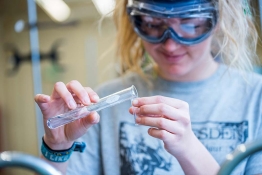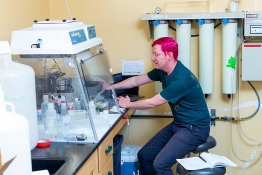Joshua Smith
Organometallic Aryne Chemistry
Attempts are being made to synthesize, and, perhaps, directly observe small aryns (e.g., benzyne) bound to the metals facially. These complexes are expected to open new routes to a new class of substituted aromatic metal complexes by reactions with nucleophiles and to allow novel entries into the synthesis of new and interesting bicyclic ring systems after trapping with dienes in situ.
Molecular Electronics
Using molecules as electronic components has become a major field of chemical research recently. This is partly driven by the need for smaller components for computer processors as we approach the size limit of silicon semiconductors. The main focus of this research is to find candidates for single molecule wires. One such system is based on a Si-alkyne backbone. The electrons will move along the wire via hyperconjugation of the Si sigma and C-C triple bond pi systems. The wire's properties will be varied by changing the groups attached to the Si. At this point the desired molecules have been synthesized, but we have yet to test their conductivity in a real world setting. They have been found to posess interesting conugative behavior, though.
Organic Photovoltaics
Traditional photovoltaic (PV) substrates are primarily based on crystals of inorganic compounds (e.g., silicon). The inorganic PV substrates have proven to be reliable and efficient and are used in a wide variety of applications from providing power to street signs to powering the International Space Station. Traditional, inorganic based solar cells, however, are relatively expensive to manufacture (although costs are declining) and have limitations in terms of their flexibility, i.e., they are rigid. Solar cells manufactured using organic photovoltaic (OPV) compounds are less expensive to produce and can be made on a flexible plastic sheet. They have not yet been found to be as efficient and robust as inorganic PVs, but these differences are being reduced every year. The efficiency of a solar cell becomes less important when one considers the cost of manufacturing and the versatility of having a flexible solar cell may bring.
Currently we are attempting to synthesize an acceptor molecule that may be used in an OPV cell. It is composed of a phenylpyridylthiadiazole moiety. Once synthesized a cell will be fabricated and tested.
Specialty Area
Organic, Organometallic, Physical Organic, Computational Chemistry, Molecular Electronics, and Organic Photovoltaic Chemistry
Education
Courses Taught
Publications











